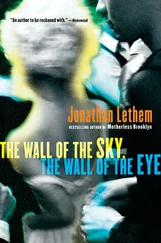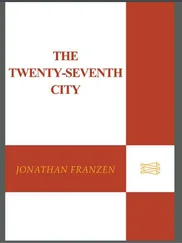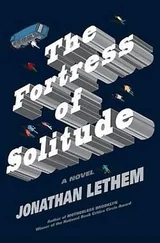Fair enough, but what did this have to do with the dog? “Each day Ava traces the scent map of the real, beyond which nothing matters to her. She’s aware that the world requires reassembly each time through it. And think of what Manhattan is to a dog , Chase! If she can endure living in our daydream, we should be able to tolerate living in someone else’s!” Now that Perkus hiccuped openly before me, with evident relief he allowed the gasping intervals to open in his speeches, ellipsis made audible. The asynchronous music of his potholed speech united the Friendreth Purities with their opposite, those floodgates of paranoiac explanation that periodically opened. “Something happened, Chase, there was some rupture in this city. Since then, time’s been fragmented. Might have to do with the gray fog, that or some other disaster. Whatever the cause, ever since we’ve been living in a place that’s a replica of itself, a fragile simulacrum, full of gaps and glitches. A theme park , really! Meant to halt time’s encroachment. Of course such a thing is destined always to fail, time has a way of getting its bills paid. So these disjunctions appear, and we have to explain them away, as tigers or epic sculpture. If Noteless didn’t exist the city would have had to invent him, Chase!” The more Perkus fleshed this theory the more the holes in his speech began to seem a kind of necessary reply to the temporal lacunae he felt the city had fallen into, as well as to Laird Noteless’s bottomless pits and absent structures.
Perkus seemed to need Manhattan to be both a falsehood and in ruins (“This town is wearing tatters”) to make good on his intuitions. But Manhattan wasn’t shattered in the sense that Mick Jagger had indicated in 1978, the way Perkus needed it to be. By recent measures the city was orderly, flush with money, a little boring, even. That was, if you trusted the complacent testimony of the millions who checked TigerWatch in the morning before donning their April snowshoes and subwaying to work as usual, then in the evenings filled the bars and restaurants, or stayed home to watch The Sopranos or the Yankees, speed-dialing to stir Chinese-delivery bicyclists to flight. There was Perkus’s point, proved: the slumbering millions who never pierced or even nudged the veil of dream. I was one of them, a born sucker, but at least I was here listening to his dire facts. Was he a conspiracy theorist? He spat like I’d said rock critic . The only conspiracy was a conspiracy of distraction . The conspirers, ourselves. If I didn’t grasp this law of complicity I should go back to the beginning and start again. When he said this, I thought of Susan Eldred’s office, my first sight of his antithetical eye.
There was another dire fact Perkus wanted me to know without telling me. Something too big to be told. The sky would come crashing down if he told it, so I had to absorb it by implication. In this mysterious matter I was intended to understand Perkus had spared me the worst (I thought he’d spread pretty bad tidings already), and that this secret had to do with women generally, or with Oona Laszlo specifically, or both. Yet he wanted to dance on the precipice of telling it. One day he passingly referred to Oona as “your chaldron,” by which he meant nothing good. I found him scratching this itch again the very last day I visited him by myself. That is to say, the day before the day Richard Abneg and I finally dragged him out of the Friendreth Canine Apartments, too late.
These days Ava would come rushing to the door as I came in, plainly eager for more company but also appearing to be concerned for Perkus, wishing to scoot me in to where he sat or sometimes lay on the carpet, twitching in glee over some storage-space flotsam like the Warren Zevon LP Excitable Boy (he loved a song called “Roland the Headless Thompson Gunner”) or, in this case, the latest find, a commercial videotape he’d rescued from a pug’s quarters, a Steve Martin comedy called Dead Men Don’t Wear Plaid .
“Watch-” A hiccup destroyed this word, so he began again. “Watch this with me, Chase, it’s brilliant.”
“Have you eaten?” He looked disastrous: sallow, skeletal, un-shaved, exultant. “I brought sandwiches.” I stuck to his preferences, not daring to have some variation rejected, just wanting to see nutrition go in. So pastrami, Diet Coke, pickle spears. There was no coffee brewed. He’d suddenly abandoned coffee, too.
“It’s not sitting well.”
“What’s not?”
“Food.” Unspoken, but heard, was You idiot!
The black-and-white Dead Men Don’t Wear Plaid was a satirical film noir, and a curious amalgam of twelfth-grade tit jokes and an elaborate intertextual trick: Steve Martin’s character, a stooge of a private eye, is allowed by the magic of editing to interact with a number of dead performers from ancient movies, Barbara Stanwyck, James Cagney, Humphrey Bogart, and so on. The element, practically an avant-garde gesture, was fascinating and stillborn, destroying any possible mood or rhythm. But incredibly to me, Perkus had located in Dead Men Don’t Wear Plaid another sacred item. I guess Perkus identified with Martin’s detective, for the way he breezed in and out of the archival footage, reanimating his own pantheon of heroes. This was analogous to how Perkus saw himself moving amid Brando, Groom, Krim, Cassavetes, Mailer, Marplot, Serling, and all the others.
Or so I was thinking, as I sat trying to grasp Perkus’s intensity yet again. It was then we came to what it turned out he regarded as the key scene. Steve Martin, whose relations with the femme fatale are absurdly abusive and overwrought, opens the cabinet behind his bathroom mirror and finds a note he’s taped there, intended to remind him on a daily basis of something he needs to know: “Guns Don’t Kill Detectives, Love Does.” Perkus spoke these words aloud as they appeared on the screen, forcing himself past the urge to hiccup at the cost of a wrenching shudder. “Guns! Don’t! Kill! Detectives! Love! Does! You see that, Chase?”
“Funny.”
“What’s funny about it?” Perkus’s voice was sharp. He was suddenly spoiling for trouble, an interpretive high noon. Ava got up on all threes and pointed her nose to the door, to meet whatever invader his tone signaled.
I tried, as ever, to meet his standard. “Well, I guess it distills Raymond Chandler’s lifework to a bumper sticker…” I’d personally always thought the hard-boiled mode wearisome to begin with, so its sending-up felt pretty fish-in-a-barrel.
“Sure, it does that, you’re right. But that’s not what kills me about this scene.”
What kills you? I wanted to scream. What kills me is how you smell as if you haven’t showered any more recently than your pit bull friend, how your former impeccable suits have degenerated into the same New York Cosmos sweatshirt worn for weeks on end, how your haircut and speech and self-awareness have all gone as crooked as your eye, how your long intellectual voyaging has culminated in a Steve Martin flick. I wasn’t going to be swayed into this latest and least of epiphanies, I swore. The closer I looked the more I felt I’d been overlooking the obvious, my eye trained too incrementally on Perkus’s details to survey the whole grim trend. He was falling apart, falling down. I couldn’t believe I’d let him fall so far. Or that other eyewitnesses, guilty bystanders, hadn’t stepped in-I blamed them for what I hadn’t seen myself.
“Have you showed this film to Sadie Zapping?” I asked, craftily, I thought.
“Sadie quit coming around,” he said. His hand flipped up to flag contempt. “She kept wanting me to try these stupid cures. I swallowed so much water I bloated like a tick. What I love about this scene, Chase, isn’t simply that Martin’s epigraph cuts so deep into the heart of the matter, but that having arrived at such an essential admonition, he actually forgets it and needs to be reminded each day at his shaving mirror!”
Читать дальше












